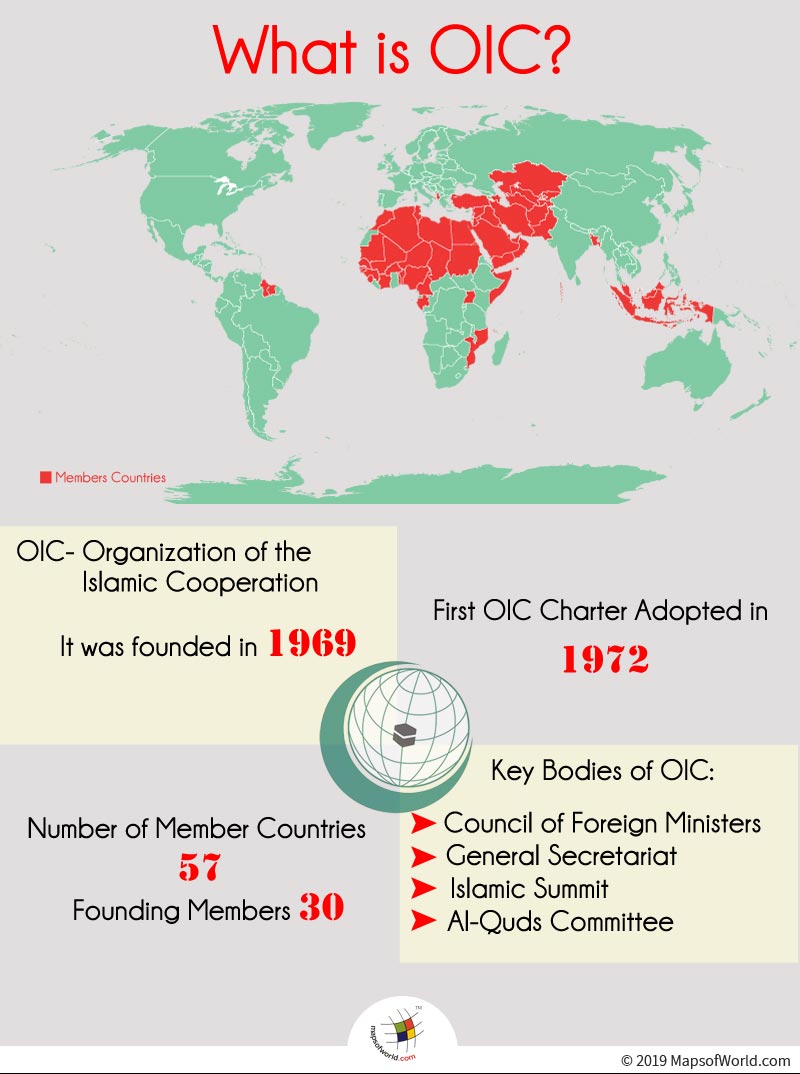What is the Organization of the Islamic Cooperation?

The Organization of Islamic Cooperation, commonly referred to as the OIC, is an international body comprising of Muslim-majority countries in the world. The organization was founded in 1969 with 30 members. Over the years, the organization has witnessed an increase in membership, and today has 57 members countries. As per the organization, it is the collective voice of the Muslim world. The organization aims to protect the interests of the Muslim countries in the spirit of promoting international peace and harmony among the people of the world. Arabic, French and English are the official languages of the OIC.
Foundation
Following the arson at the Al-Aqsa Mosque in Jerusalem on August 21, 1969, an Islamic conference was held in Rabat, Morocco, on September 25, 1969. The conference was attended by the representatives of 24 Muslim-majority countries. The First Islamic Conference was held in March 1970 in Jeddah Saudi Arabia, and at the conference it was decided that a permanent secretariat in Jeddah would be established. The secretariat was to be headed by the secretary general. The current secretary general is Dr. Yousef Ahmed Al-Othaimeen who is a Saudi Arabian politician. The first OIC charter was adopted in 1972, which laid down the objectives and principles of the organization. The current charter was adopted in Dakar on March 13-14, 2018, by the Eleventh Islamic Summit.
Goals of the OIC
The main purpose of the establishment of the organization is to protect and safeguard the interests of the Muslim countries. As per the OIC’s charter, the goals include: Promoting solidarity among member states; advance education, mainly in the science and technology fields; preserving Islamic social and economic values; uphold international peace and security; and increase cooperation in social, economic, cultural, scientific, and political areas. The OIC’s emblem contain three main elements, which are: The Globe, Kaaba, and the Crescent.
Members of the OIC
Currently, the OIC has 57-member countries with a collective population of more than 1.9 billion, as of 2018. Barring Palestine, the rest of the countries are member states of the United Nations. Some OIC members in South America and the western part of Africa may not be Muslim-dominated nations, but have a significant Muslim population. Russia and Thailand have huge Muslim populations and thus have been included as Observer States.
Key bodies of the OIC
The main bodies of the organization are the Council of Foreign Ministers, the General Secretariat, the Islamic Summit, the Al-Quds Committee, and three committees which relate to economy and trade, science and technology, and information and culture. Some of the specialized organs of the OIC are the Islamic Development Bank, the Islamic Educational, Scientific and Cultural Organization, etc.
Below is the list of 57 Countries that are the Members of The OIC:
| S.No. | Country | Year of Joining |
| 1 | Afghanistan | 1969 |
| 2 | Albania | 1992 |
| 3 | Algeria | 1969 |
| 4 | Azerbaijan | 1992 |
| 5 | Bahrain | 1972 |
| 6 | Bangladesh | 1974 |
| 7 | Benin | 1983 |
| 8 | Brunei | 1984 |
| 9 | Burkina Faso | 1974 |
| 10 | Cameroon | 1974 |
| 11 | Chad | 1969 |
| 12 | Comoros | 1976 |
| 13 | Djibouti | 1978 |
| 14 | Egypt | 1969 |
| 15 | Gabon | 1974 |
| 16 | Gambia | 1974 |
| 17 | Guinea | 1969 |
| 18 | Guinea-Bissau | 1974 |
| 19 | Guyana | 1998 |
| 20 | Indonesia | 1969 |
| 21 | Iran | 1969 |
| 22 | Iraq | 1975 |
| 23 | Côte d’Ivoire | 2001 |
| 24 | Jordan | 1969 |
| 25 | Kazakhstan | 1995 |
| 26 | Kuwait | 1969 |
| 27 | Kyrgyzstan | 1992 |
| 28 | Lebanon | 1969 |
| 29 | Libya | 1969 |
| 30 | Malaysia | 1969 |
| 31 | Maldives | 1976 |
| 32 | Mali | 1969 |
| 33 | Mauritania | 1969 |
| 34 | Morocco | 1969 |
| 35 | Mozambique | 1994 |
| 36 | Niger | 1969 |
| 37 | Nigeria | 1986 |
| 38 | Oman | 1972 |
| 39 | Pakistan | 1969 |
| 40 | Palestine | 1969 |
| 41 | Qatar | 1972 |
| 42 | Saudi Arabia | 1969 |
| 43 | Senegal | 1969 |
| 44 | Sierra Leone | 1972 |
| 45 | Somalia | 1969 |
| 46 | Sudan | 1969 |
| 47 | Suriname | 1996 |
| 48 | Syria | 1972 |
| 49 | Tajikistan | 1992 |
| 50 | Togo | 1997 |
| 51 | Tunisia | 1969 |
| 52 | Turkey | 1969 |
| 53 | Turkmenistan | 1992 |
| 54 | Uganda | 1974 |
| 55 | United Arab Emirates | 1972 |
| 56 | Uzbekistan | 1996 |
| 57 | Yemen | 1969 |
Related Links:
Related Map:

